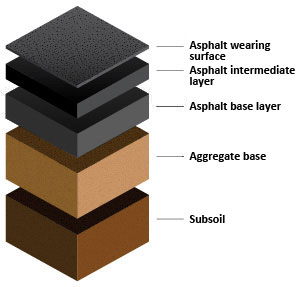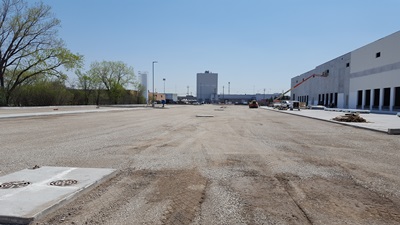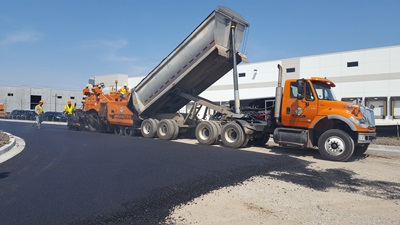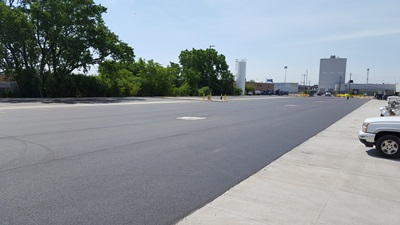Parking Lots - The Basics
General
Nearly all building structures will incorporate some parking features to accommodate their workers, customers, and deliveries. Office buildings and retail stores across America are opening their doors and trying to attract new customers. First impressions are critical and the parking lot serves as a crucial gateway to what that first impression might be. The following is a basic overview of the components of commercial asphalt pavement, keep in mind that depending on soil conditions and anticipated loading the typical section can change
Typical Section
Asphalt pavements are typically characterized as a layered system where different materials are utilized and each layer contributes to the overall strength and function of the pavement structure. Most parking lots are built on a foundation of native subgrade soils and an aggregate layer (typically dense graded aggregate) to provide load-carrying structure and to improve the working platform for the asphalt paving materials. Following the placement and compaction of the soil and aggregate layers, two or more layers of asphalt pavement are added to complete the pavement structure. The most common approach is to utilize a base asphalt mixture over the aggregate layer and then to utilize a surface mixture as the final riding course. Full-depth asphalt may also be used
lots are built on a foundation of native subgrade soils and an aggregate layer (typically dense graded aggregate) to provide load-carrying structure and to improve the working platform for the asphalt paving materials. Following the placement and compaction of the soil and aggregate layers, two or more layers of asphalt pavement are added to complete the pavement structure. The most common approach is to utilize a base asphalt mixture over the aggregate layer and then to utilize a surface mixture as the final riding course. Full-depth asphalt may also be used
Drainage
Adequate drainage of the pavement structure is considered one of the most important factors in parking lot. Possibly no other feature is as important in determining the ability of a pavement to withstand the effects of weather and traffic. Once water initially enters the subgrade, it is usually slow to evaporate or drain. Even in dry weather, the subgrade may remain wet or damp indefinitely. Most subgrade soils contain some silt and clay, which lose strength when wet
The subgrade and aggregate layer should be properly shaped to ensure the pavement surface is sloped to drain stormwater from the surface. The pavement should have a slope from crown-to-edge of 2% (¼-inch per linear foot). Sodded areas must be graded to drain water away from the pavement
It is absolutely critical that any pavement be well designed for proper drainage. Drainage problems are frequently a major cause of parking area pavement failures and should be given special consideration during the design and construction phases. Without proper drainage, stormwater may cause premature deterioration of the surface layers. In addition, moisture will penetrate into the subgrade layers, which could weaken the entire pavement structure resulting in severe distress
Subgrade & Aggregate Base
 Proper preparation of the subgrade is essential since the subgrade must serve both as a working platform to support construction equipment and as the foundation for the final pavement structure. During construction, the native soils may be evaluated by proof-rolling the area using heavy construction equipment. This is done to identify any unsuitable or soft areas that need to be removed or improved prior to placing subsequent layers. Unsuitable soils can be improved by blending aggregates with soil or by chemical stabilization using cement, kiln dust, or hydrated lime. All debris, topsoil, vegetation, or unsuitable materials should be removed and replaced with quality materials. It should be shaped to match the final contour of the finished surface
Proper preparation of the subgrade is essential since the subgrade must serve both as a working platform to support construction equipment and as the foundation for the final pavement structure. During construction, the native soils may be evaluated by proof-rolling the area using heavy construction equipment. This is done to identify any unsuitable or soft areas that need to be removed or improved prior to placing subsequent layers. Unsuitable soils can be improved by blending aggregates with soil or by chemical stabilization using cement, kiln dust, or hydrated lime. All debris, topsoil, vegetation, or unsuitable materials should be removed and replaced with quality materials. It should be shaped to match the final contour of the finished surface
All fill materials should be placed in thin lifts (12 inch maximum) at the proper moisture content and compacted prior to placement of the next lift. A properly prepared subgrade will not deflect excessively under the weight of a loaded truck. Prior to the start of paving operations, the subgrade soils should be checked for stability, moisture content, and proper grade. For projects designed with a layer of stone between the soil subgrade and the asphalt pavement, that layer must also be placed and compacted to proper moisture content, density and grade
Asphalt Base Layer
The asphalt base course should be placed directly on the soil subgrade (full-depth design) or on the prepared aggregate base (aggregate base design). Asphalt mixtures used in base applications are characterized by larger aggregates and are typically placed in thicker layers. The base layer should be placed and compacted to the thickness indicated on the plans. The thicknesses shown on the plans represent the finished and compacted pavement thickness – not the loose thickness prior to compaction. Compaction of the asphalt base layers is critical to the performance of the pavement because it provides the structural foundation to support the weight of the traffic. In order to achieve compaction of a base mixture, research and experience indicates that the thickness of the layer must be at least three times the size of the largest aggregate in the mixture. See minimum lift thicknesses for Illinois mixes
characterized by larger aggregates and are typically placed in thicker layers. The base layer should be placed and compacted to the thickness indicated on the plans. The thicknesses shown on the plans represent the finished and compacted pavement thickness – not the loose thickness prior to compaction. Compaction of the asphalt base layers is critical to the performance of the pavement because it provides the structural foundation to support the weight of the traffic. In order to achieve compaction of a base mixture, research and experience indicates that the thickness of the layer must be at least three times the size of the largest aggregate in the mixture. See minimum lift thicknesses for Illinois mixes
Asphalt Surface Layer
 The asphalt surface layer is typically placed in one layer and compacted to the finish grade shown on the plans. The surface should not vary from the established grade by more than ¼ inch in 10 feet when measured in any direction. Rolling and compaction should start as soon as the asphalt material can be compacted without displacement and continue until it is thoroughly compacted and all the roller marks disappear. . In order to achieve compaction of a surface mixture, research and experience indicates that the thickness of the layer must be at least three times the size of the largest aggregate in the mixture. See minimum lift thicknesses for Illinois mixes
The asphalt surface layer is typically placed in one layer and compacted to the finish grade shown on the plans. The surface should not vary from the established grade by more than ¼ inch in 10 feet when measured in any direction. Rolling and compaction should start as soon as the asphalt material can be compacted without displacement and continue until it is thoroughly compacted and all the roller marks disappear. . In order to achieve compaction of a surface mixture, research and experience indicates that the thickness of the layer must be at least three times the size of the largest aggregate in the mixture. See minimum lift thicknesses for Illinois mixes
Tack Coat
The purpose of a tack coat is to promote the bond between pavement layers. A tack coat may be used between the asphalt layers. A tack coat may not be required if the asphalt layers are placed in subsequent days and the surface remains clean and free of dust. Older pavement surfaces that will receive an overlay and milled surfaces will often utilize a tack coat
asphalt layers are placed in subsequent days and the surface remains clean and free of dust. Older pavement surfaces that will receive an overlay and milled surfaces will often utilize a tack coat
The tack coat material is typically placed just prior to paving and must be applied to a surface that is clean and free of debris or loose materials. Most tack coat products are asphalt emulsions which need some time to "break" or cure. After the tack coat cures, the pavement is ready for the next layer of asphalt. The time necessary for the tack coat to cure is dependent on the type of tack coat, condition of existing material, and weather conditions at the time of placement
Additional Stories: Arrow Road Goes Stringless! What is Asphalt Pavement?

